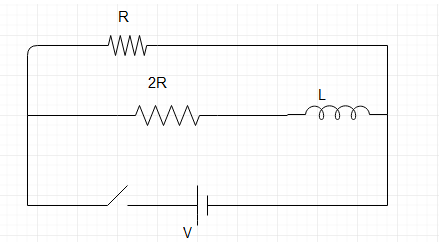
Find the ratio of time constant in build up and decay in the circuit as shown in the flowing figure-

A. 1:1
B. 3:2
C. 2:3
D. 1:3

Answer
557.7k+ views
Hint: The time constant for an RL circuit shows us the amount of time the circuit takes to conduct 63.2% of the current that flows on account of potential difference applied to its end. The formula of time constant is \[T=\dfrac{L}{R}\]. The current flowing through a conductor does not change spontaneously but with the passage of time.
Complete step by step answer:
The inductor, L is in series with the resistance 2R in the second branch of the given circuit. So, the Time constant in Build up is given as \[{{T}_{1}}=\dfrac{L}{2R}\].
Now talking about decay, time constant is given by, \[{{T}_{2}}=\dfrac{L}{3R}\]
So, taking the ratio of the two time constants we get, \[\dfrac{{{T}_{1}}}{{{T}_{2}}}=\dfrac{2}{3}\]
So, the correct option is (b)
Note:Inductor always opposes the flow of current through it. An ideal inductor pays no opposition to the flow of current but in reality, no ideal inductor exists. When current flows through the inductor it changes and self-induced emf within the inductor as a result of the growth of magnetic flux, (Lenz’s Law) is produced which opposes the cause of its growth. As the time goes on, external potential neutralizes the effect of the self-induced emf, the current flow becomes constant and the induced current and field are reduced to zero. The Time Constant of the LR series circuit represents the final steady state current value after five-time constant values.
Complete step by step answer:
The inductor, L is in series with the resistance 2R in the second branch of the given circuit. So, the Time constant in Build up is given as \[{{T}_{1}}=\dfrac{L}{2R}\].
Now talking about decay, time constant is given by, \[{{T}_{2}}=\dfrac{L}{3R}\]
So, taking the ratio of the two time constants we get, \[\dfrac{{{T}_{1}}}{{{T}_{2}}}=\dfrac{2}{3}\]
So, the correct option is (b)
Note:Inductor always opposes the flow of current through it. An ideal inductor pays no opposition to the flow of current but in reality, no ideal inductor exists. When current flows through the inductor it changes and self-induced emf within the inductor as a result of the growth of magnetic flux, (Lenz’s Law) is produced which opposes the cause of its growth. As the time goes on, external potential neutralizes the effect of the self-induced emf, the current flow becomes constant and the induced current and field are reduced to zero. The Time Constant of the LR series circuit represents the final steady state current value after five-time constant values.
Recently Updated Pages
A man running at a speed 5 ms is viewed in the side class 12 physics CBSE

The number of solutions in x in 02pi for which sqrt class 12 maths CBSE

State and explain Hardy Weinbergs Principle class 12 biology CBSE

Write any two methods of preparation of phenol Give class 12 chemistry CBSE

Which of the following statements is wrong a Amnion class 12 biology CBSE

Differentiate between action potential and resting class 12 biology CBSE

Trending doubts
What are the major means of transport Explain each class 12 social science CBSE

Which are the Top 10 Largest Countries of the World?

Draw a labelled sketch of the human eye class 12 physics CBSE

Explain sex determination in humans with line diag class 12 biology CBSE

Explain sex determination in humans with the help of class 12 biology CBSE

Differentiate between homogeneous and heterogeneous class 12 chemistry CBSE




